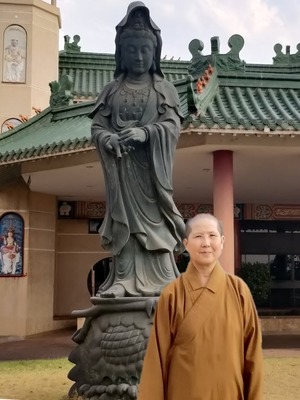
Speaker: Ven. Juedi
Fo Guang Shan Nanhua Temple, South Africa
I. Introduction
Auspicious greeting to everyone. Welcome to our Fo Guang Shan English Dharma Service Channel. I am Juedi from Nan Hua Temple in South Africa. Today I will cover the topic of Giving with Mindfulness.
During natural disasters or the Covid-19 pandemic, we saw much giving being done, especially the provision of Medical Supplies and food during this Covid-19 pandemic.
We would like to help too! But how do we give with mindfulness? You may relate mindfulness to sitting down and observing breathing. But mindfulness is not solely talking about sitting on a cushion. We can give with mindfulness.
II. The Paramita of Giving
Let me first talk about giving. Giving is one of the Buddhist practices in Six Paramitas. What is paramita? Parami is an ancient Sanskrit word that means “to cross over.” One crosses from the shore of suffering over to the opposite shore of liberation. While “ta” is an auxiliary particle that indicates completion.
When we give, we need to have the “paramita” aspect. We don’t give just to make others happy. Paramita is our aim. To make both we and the recipient cross over to the shore of liberation. We need six special tools to go to the shore of liberation. It is like we are going to migrate to another country, which requires us to have the finance or possess certain expertise to be granted permanent residency. Today I will only cover Dana or generosity paramita.
What is the difference between Dana paramita and the ordinary kind of giving? We can easily relate giving with compassion but less so with wisdom. Dana paramita is a form of giving that encompasses compassion and wisdom. The whole act of giving is dependent arising. It is dependent on the Giver, the Gift, and the Recipient. These are the three aspects of Giving.
Let’s start with the first aspect of giving, that is, the Giver.
III. First Aspect of Giving: The Giver
For example, I want to help the poor. How does mindfulness come in? I may feel very proud of myself because I have a kind heart and concern for the poor. This “I” feel so great about giving. In this case, we give in order to think well of ourselves and to think of ourselves as being generous. Another possible reason is we fall into the subconscious view of status. The status of a generous person and a pitiful person. We created this kind of status level in our minds without realizing it. If we are mindful, then we can see the ego within us. The desire to give is good, but we need to see the intention. With mindfulness, we can observe those mixed motives, be they pure or impure. We may start with a less than perfect mind of generosity, but over time, we put aside our ego while giving. We have to be patient with our practice of generosity and embrace whatever mixed motives that we might have now.
When practicing Dana Paramita, it doesn’t mean that we can fulfill everybody’s needs and wants. It is impossible to satisfy sentient beings. I’ve to emphasize, giving within our means. We shouldn’t give until we feel uncomfortable. There is no Paramita here! When we feel stressed then we are not liberating ourselves to the shore of happiness. It’s not about fulfilling all sentient beings’ needs and wants to perfect giving. We need to be wise and realistic in our giving.
IV. Second Aspect of Giving: The Gift
Next, is the second aspect, that is, the “gift.” It is winter in South Africa right now. Okay, for this winter, I’m going to donate 1,000 dollars. This is considered a lot for a person who is not working. So be grateful. It seems like we are parting off 1,000 dollars, but we still hang on to this “gift”. This is not an ordinary “gift”. This is a gift from someone who is not well-off. Being mindful means, we don’t add intangible value to the gift on top of the monetary value of the gift itself. A gift is a way to communicate with the receiver. It connects the giver and receiver.
There are different types of Gifts in Buddhism
· Firstly, giving of wealth
· Secondly, giving of Dharma or words of wisdom
· Thirdly, giving fearlessness
The first one, giving cash, includes money, food, materials, and time. One could either give money, food, or volunteer their time to provide services to those in need. For example, during this Covid-19 pandemic, we noticed many healthy adults helping the elderly to get groceries so that they could stay at home.
While giving, we must combine our generosity with wisdom. For example, we don’t give things that are going to be harmful to other people. We don’t give drugs. We don’t give money if we fear that it’s going to be misused. Don’t give things that people aren’t supposed to have.
The second point is the giving of Dharma. Giving Dharma is the highest form of giving because it can end one’s suffering. It means giving and sharing Dharma to those who are willing and ready to listen. The giving of dharma means making the teachings available by supporting Buddhist centres, giving Buddhist lectures, and publishing books.
The third point is giving fearlessness. That is to give protection and relieve the fears of others. A very good example in this recent pandemic is giving of face masks. This giving fulfilled the giving of material items and the giving of fearlessness. A less obvious but is the best form of giving fearlessness is the observation of the Five precepts. By upholding no killing, no stealing, no sexual misconduct, no lying, and no intoxication, we are giving fearlessness to people around us.
V. Third Aspect of Giving: The Recipient
We now come to the third aspect, which is “the recipient”. I offer to help you. You are so pitiful. You must be happy that I’m helping you. You must be grateful… the list goes on. If we are not mindful, we not only see ourselves as superior to the recipient but also with an expectation of return. For instance, we ask someone to pay forward. Even, asking someone to pay forward is an expectation!
To put the above in perspective, I will quote from the Sumati Sutra. The sutra mentions four stages of developing Dana Paramita:
The first is to give a timely gift, the second is to give without a mind of disdain for others; the third is to give with a happy mind, and lastly to give without expecting any reward.
Ten Path to Happiness
When we practice giving with mindfulness, we can use these four points to reflect our body, speech, and mind.
We now move on to the receiving end. We may think that the other party is happy, or we have relieved their problems. This may or may not be true. During our Zoom meeting discussion about this topic of giving, one of our participants mentioned that she doesn’t like to take things from others. She felt the pressure on her to repay the kindness in whatever form. Hence, to achieve paramita (which is also called completion), the donation should make the recipient happy and relieve suffering rather than add an emotional or financial burden to them.
VI. Give with Compassion and Wisdom
Let me share an incident that happened about ten years ago. There was a male student from the Fo Guang Shan Buddhist college whose family lives from hand to mouth relying on his mother to run a small food stall. [Slide 20] But towards the end of his first year in the Buddhist college, his mother became very sick, and the family started to worry about meeting their daily needs. When I heard about that, I thought to myself, maybe … we can give his family some money to tide over this critical period. [Slide 21] But Venerable Master Hsing Yun suggested that since the school holiday was coming, we can encourage his classmates to help in his mother’s stall. These students then worked together to sell food at the stall during the school holidays. The financial issues were resolved, and the mother finally recovered before the school reopened. Also, there was better bonding between the classmates and the family’s pride was being taken care of.
From this incident, we see that we can choose the easy way out of just giving away money. However, Venerable Master Hsing Yun maintains an openness to others that enables him to be aware of the student’s financial and emotional needs. Henceforth, Dana paramita encompasses compassion and wisdom. Without wisdom, giving money may be counterproductive or misguided. In this example, we might have hurt the young man’s dignity unintentionally. Giving isn’t about the transfer of money or material things from here to there.
VII. Conclusion
When one aspires to give, the other person must aspire to receive as well. Conversely, if one is willing to give but the other person refuses to receive then generosity cannot be expressed. The principle of Buddhist generosity advocates that “the giver and receiver are not different from one another.” Thus, there is only mutual respect instead of differentiation between self and others.
Therefore, as a giver, when we are mindful of our motivation, we are free from pride, free from attachment over the gift, and free from expectation. For the receiver, it is a moment of joy and relief without any burden of repaying. Hence, it is a win-win situation for both of them.
When we give with mindfulness, then we can perfect our giving, benefitting ourselves and others.
And lastly, may you find joy in giving and receiving. Goodbye!

